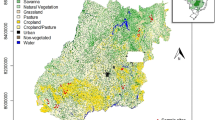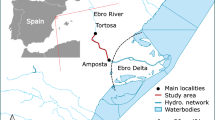Abstract
Often ecologists and natural resource managers can easily access data on invasive species occurrence across a region. Yet, collecting species abundance data over a large area is arguably more important for decision making, but inherently costly, so methods which can provide robust information at low-cost are particularly valuable. Studies of species distribution often use occurrence data to build models of the environmental niche. Environmental suitability derived from such models may be used to predict the potential distributions of species. The ability of such models to predict spatial patterns in abundance have recently been demonstrated. Here we tested the relationship of environmental suitability with local abundance of an aquatic invasive species, olive hymenachne (Hymenachne amplexicaulis) in the Wet Tropics of Australia. Ordinary least squares and quantile regressions revealed a positive relationship between environmental suitability and local abundance of olive hymenachne. We expand on this and use the relationship between environmental suitability and local abundance to quantify the effectiveness of management (reduction in local abundance) under four different management investments. We show that the upper limit of abundance can be used to evaluate management effectiveness based on varying investments, and that ongoing management is the most effective at reducing local abundance. We discuss implications of this in addressing important problems in invasive species management.


Similar content being viewed by others
References
Armour J, Cogle L, Rasian V, Russell J (2004) Sustaining the Wet Tropics: a regional plan for natural resource management. Rainforest CRC and Far North Queensland NRM Ltd, Cairns, p 115
Blossey B (1999) Before, during and after: the need for long-term monitoring in invasive plant species management. Biological Invasions 1:301–311
Bradley BA, Wilcove DS, Oppenheimer M (2010) Climate change increases risk of plant invasion in the Eastern United States. Biological Invasions 12:1855–1872
Cade BS, Terrell JW, Schroeder RJ (1999) Estimating effects of limiting factors with regression quantiles. Ecology 80:311–323
Christian-Smith J, Merenlender AM (2010) The disconnect between restoration goals and practices: a case study of watershed restoration in the Russian River Basin, California. Restoration Ecology 18:95–102
Chytrý M, Jarošíik V, Pyšek P, Hájek O, Knollová I, Tichý L, Danihelka J (2008) Separating habitat invasibility by alien plants from the actual level of invasion. Ecology 89:1541–1553
Clark JS, Carpenter SR, Barber M, Collins S, Dobson A, Foley JA, Lodge DM, Pascual M, Pielke R, Pizer W, Pringle C, Reid WV, Rose KA, Sala O, Schlesinger WH, Wall DH, Wear D (2001) Ecological forecasts: an emerging imperative. Science 293:657–660
Colautti RI, Grigorovich IA, MacIsaac HJ (2006) Propagule pressure: a null model for biological invasions. Biological Invasions 8:1023–1037
DERM (2004) Queensland Department of Environment and Resource Management, Soil and land resource spatial data. http://www.derm.qld.gov.au/science/slr/soil_publications.html. Accessed November 2008
DERM (2009) Queensland Department of Environment and Resource Management, Wetland Mapping and Classification, Brisbane
Didham RK, Tylianakis JM, Hutchison MA, Ewers RM, Gemmell NJ (2005) Are invasive species the drivers of ecological change? Trends in Ecology and Evolution 20:470–474
Downs PW, Kondolf GM (2002) Post-project appraisals in adaptive management of river channel restoration. Environmental Management 29:477–496
DSEWPC (2010) Department of Sustainability, Environment, Water, Population and Communities. http://www.environment.gov.au/parks/nrs/science/bioregion-framework/ibra/index.html#ibra. Accessed February 2011
Dullinger S, Kleinbauer I, Peterseil J, Smolik M, Essl F (2009) Niche based distribution modelling of an invasive alien plant: effects of population status, propagule pressure and invasion history. Biological Invasions 11:2401–2414
Elith J, Graham CH, Anderson RP, Dudík M, Ferrier S, Guisan A, Hijmans RJ, Huettmann F, Leathwick JR, Lehmann A, Li J, Lohmann LG, Loiselle BA, Manion G, Moritz C, Nakamura M, Nakazawa Y, Overton JMM, Townsend Peterson A, Phillips SJ, Richardson K, Scachetti-Pereira R, Schapire RE, Soberón J, Williams S, Wisz MS, Zimmermann NE (2006) Novel methods improve prediction of species’ distributions from occurrence data. Ecography 29:129–151
Epanchin-Niell RS, Hastings A (2010) Controlling established invaders: integrating economics and spread dynamics to determine optimal management. Ecology Letters 13:528–541
ESRI (2008) ArcGIS 9.3. Environmental Systems Research Institute, Redlands
Ficetola GF, Maiorano L, Falcucci A, Dendoncker N, Boitani L, Padoa-Schioppa E, Miaud C, Thuiller W (2010) Knowing the past to predict the future: land-use change and the distribution of invasive bullfrogs. Global Change Biology 16:528–537
Fielding AH, Bell JF (1997) A review of methods for the assessment of prediction errors in conservation presence/absence models. Environmental Conservation 24:38–49
Gordon E, Yasmira FEO (2007) Growth dynamics of Hymenachne amplexicaulis in a herbaceous wetland in Miranda State (Venezuela). Acta Botanica Venezuela 30:1–18
Houlder D, Hutchinson M, Nix H, McMahon J (1999) ANUCLIM version 5 user guide. Centre for Resource and Environmental Studies, Australian National University, Canberra
Houston WA, Duivenvoorden LJ (2002) Replacement of littoral native vegetation with the ponded pasture grass Hymenachne amplexicaulis: effects on plants, macroinvertebrate and fish biodiversity of backwaters in the Fitzroy River, Central Queensland, Australia. Marine and Freshwater Research 53:1235–1244
Januchowski SR, Pressey RL, VanDerWal J, Edwards A (2010) Characterizing errors in digital elevation models and estimating the financial costs of accuracy. International Journal of Geographical Information Science 24:1327–1347
Januchowski SR, Visconti P, Pressey RL (2011) A systematic approach for prioritizing multiple management actions for invasive species. Biological Invasions 13:1241–1253
Johnson BL (1999) The role of adaptive management as an operational approach for resource management agencies. Ecology and Society 3:8. http://wwwecologyandsocietyorg/vol3/iss2/art8/
Lass LW, Carson HW, Callihan RH (1996) Detection of yellow starthistle (Centaurea solstitialis) and common St Johnswort (Hypericum perforatum) with multispectral digital imagery. Weed Technology 10:466–474
Liu CR, Berry PM, Dawson TP, Pearson RG (2005) Selecting thresholds of occurrence in the prediction of species distributions. Ecography 28:385–393
Lockwood JL, Cassey P, Blackburn T (2005) The role of propagule pressure in explaining species invasions. Trends in Ecology and Evolution 20:223–228
Palmer MA, Bernhardt ES, Allan JD, Lake PS, Alexander G, Brooks S, Carr J, Clayton S, Dahm CN, Shah JF, Galat DL, Loss SG, Goodwin P, Hart DD, Hassett B, Jenkinson R, Kondolf GM, Lave R, Meyer JL, O’Donnell TK, Pagano L, Sudduth E (2005) Standards for ecologically successful river restoration. Journal of Applied Ecology 42:208–217
Park K (2004) Assessment and management of invasive alien predators. Ecology and Society 9:12. http://wwwecologyandsocietyorg/vol9/iss2/art12/
Peterson AT (2003) Predicting the geography of species invasions via ecological niche modeling. The Quarterly Review of Biology 78:419–433
Peterson AT, Vieglais DA (2008) Predicting species invasions using ecological niche modeling: new approaches from bioinformatics attack a pressing problem. Bioscience 51:363–372
Peterson AT, Papes M, Eaton M (2007) Transferability and model evaluation in ecological niche modeling: a comparison of GARP and Maxent. Ecography 30:550–560
Phillips SJ (2008) Transferability, sample selection bias, background data in presence-only modelling: a response to Peterson and others (2007). Ecography 31:272–278
Phillips SJ, Dudik M (2008) Modeling of species distributions with Maxent: new extensions and a comprehensive evaluation. Ecography 31:161–175
Phillips SJ, Anderson RP, Schapire RE (2006) Maximum entropy modeling of species geographic distributions. Ecological Modelling 190:231–259
Pusey BJ, Kennard MJ, Arthington AH (2004) Freshwater fishes of northeastern Australia. CSIRO, Collingwood
Pusey BJ, Kennard M, Arthington A (2008) Origins and maintenance of freshwater fish biodiversity in the Wet Tropics region. In: Stork NE, Turton SM (eds) Living in a dynamic tropical forest landscape. Blackwell, Oxford, pp 150–159
Pyšek P, Prach K (1993) Plant invasions and the role of Riparian habitats—a comparison of four species alien to Central-Europe. Journal of Biogeography 20:413–420
Roni P, McHenry M, Pess G, Beechie T (2008) Evaluating changes in salmon spawning habitat and spawners in the Elwha River following dam removal. In: Sear DA, DeVries P (eds) Salmonid spawning habitat in rivers: physical controls, biological responses and approaches to remediation. American Fisheries Society, Bethesda, pp 301–319
Scharf FS, Juanes F, Sutherland M (1998) Inferring ecological relationships from the edges of scatter diagrams: comparison of regression techniques. Ecology 79:448–460
Simberloff D (2009) We can eliminate invasions or live with them Successful management projects. Biological Invasions 11:149–157
Steiner FM, Schlick-Steiner BC, VanDer Wal J, Reuther KD, Christian E, Christian S, Suarez AV, Williams SE, Crozier RH (2008) Combined modelling of distribution and niche in invasion biology: a case study of two invasive Tetramorium ant species. Diversity and Distributions 14:538–545
Stewart GB, Pullin AS, Tyler C (2007) The effectiveness of asulam for bracken (Pteridium aquilinum) control in the United Kingdom: a meta-analysis. Environmental Management 40:747–760
Strubbe D, Matthysen E (2009) Establishment success of invasive ring-necked and monk parakeets in Europe. Journal of Biogeography 36:2264–2278
Sydes T (2009) Cross regional Hymenachne management strategy, Johnstone, Tully-Murray, Lower Herbert and Black River Catchments. Far North Queensland Regional Organisation of Councils, Cairns
Tracey JG (1982) The vegetation of the humid tropical region of North Queensland. CSIRO, Melbourne, p 124
VanDerWal J, Shoo LP, Johnson CN, Williams SE (2009) Abundance and the environmental niche: environmental suitability estimated from niche models predicts the upper limit of local abundance. The American Naturalist 174:282–291
Wang CZ, Zhou B, Palm HL (2008) Detecting invasive sericea lespedeza (Lespedeza cuneata) in Mid-Missouri pastureland using hyperspectral imagery. Environmental Management 41:853–862
Williamson MH, Fitter A (1996) The characters of successful invaders. Biological Conservation 78:163–170
Witte C, van den Berg D, Rowland T, O’Donnell T, Denham R, Pitt G, Simpson J (2006) Mapping land use in Queensland—technical report on the 1999 land use map for Queensland. Department of Natural Resources, Mines and Water, Brisbane
Yokomizo H, Possingham HP, Thomas MB, Buckley YM (2009) Managing the impact of invasive species: the value of knowing the density-impact curve. Ecological Applications 19:376–386
Acknowledgments
Support for S. Januchowski-Hartley was provided by the Weeds of National Significance Funding Scheme, administered by the Queensland Department of Employment, Economic Development and Innovation, Primary Industries and Fisheries. Support was also provided by James Cook University’s Research Advancement Program, the Australian Research Council, and Cassowary Coast Regional Council. We also thank H. Murphy, V. Hermoso and F. Januchowski-Hartley for their thoughtful review and insightful comments on earlier drafts. Thank you to T. Sydes for his unfailing encouragement and ongoing efforts to bridge the gap between research and on-ground management actions. Finally, we thank the two anonymous reviewers who greatly improved this manuscript.
Author information
Authors and Affiliations
Corresponding author
Rights and permissions
About this article
Cite this article
Januchowski-Hartley, S., VanDerWal, J. & Sydes, D. Effective Control of Aquatic Invasive Species in Tropical Australia. Environmental Management 48, 568–576 (2011). https://doi.org/10.1007/s00267-011-9686-4
Received:
Accepted:
Published:
Issue Date:
DOI: https://doi.org/10.1007/s00267-011-9686-4




